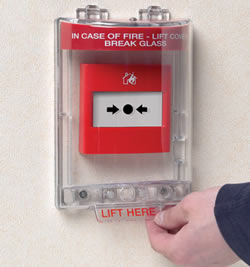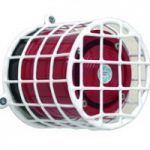
Today I will consider a further three common causes of false fire alarms and share with you our experience of how to reduce these false activations.
Malicious/Accidental Damage
All systems can be susceptible to malicious/accidental damage. However, the risk factor can vary greatly depending on the nature of your business. For example, if your business has a large footfall of traffic through the door, the risk of malicious/accidental damage is far greater.
Top Tip:
Protective Cages/Covers are an inexpensive way of reducing the risk of accidental or malicious damage. We highly recommend the use of break glass unit protective covers especially in high traffic areas. These should be readily available from any good service provider retailing from €5.00 per cover upwards.

Cages also come in all shapes and sizes and are ideal in areas prone to vandalism. These can be fitted to any device including the Fire Alarm control panel itself.
Use “Resettable” Break Glass Units. The resettable units are not only convenient but they are also cost effective as they remove the need to keep a supply of spare glass at your premises. They can also be easily reset by any member of staff, thus reducing related call out charges.
It is also worth noting that CCTV Systems can act as deterrent in area’s which are prone to vandalism/malicious damage.
Above all, remember to log all false fire alarms in the false alarm section of your Fire & General Register/Logbook. This will allow you to monitor trends and take action where needed. We also recommend reporting all false alarms to your maintenance/service provider.
Poor Maintenance
As with any system or machine, regular maintenance is essential to ensure optimum performance. Most addressable Fire Alarm panels monitor what is called the “analogue values” of devices. Devices with a high reading pose a greater risk of causing a false alarm. During routine service/maintenance visits engineer’s can identify devices with a high reading and take action before a false alarm occurs.
Top Tip:
Ensure you have a Fire Alarm Service/Maintenance Contract in place, and that your provider is competent to carry out the contract in accordance with Irish Standards 3218.
Monitor the Fire Alarm control panel on a daily basis for any pre alarms and notify your service provider of same. This duty should fall under the remit of your nominated “Responsible Person”.
Plan for Upgrade
Detection devices such as smoke detectors, heat detectors etc generally have a life Span of 10 – 15 years. Beyond this the likelihood of false alarm activations increases.
Top Tip:
Whilst proper maintenance will prolong the life of detection devices, we recommend that you consult with your service provider regarding a Phased Upgrade Plan. Not only will this spread the cost of the upgrade over a number of years, it should also considerably reduce the cost of the upgrade if devices can be changed out during a routine service visit.
Did you find this two part series useful? If so, why not subscribe to our newsletter for quarterly news updates, offers, tips and more!







